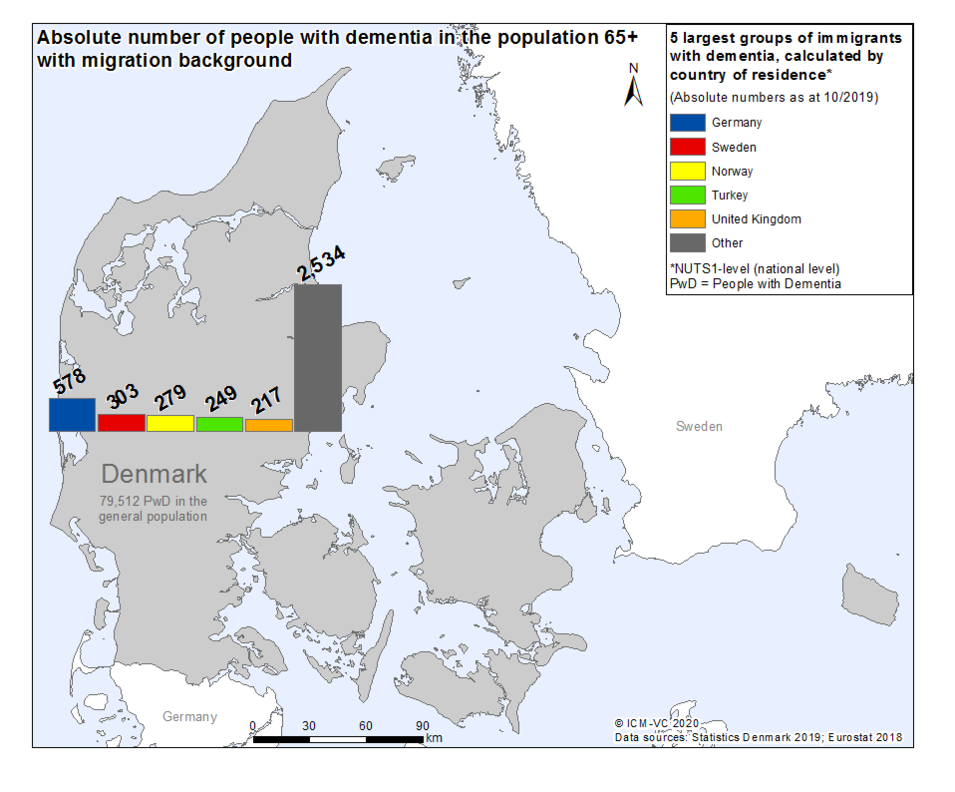EU-Atlas: Dementia & Migration
| Largest group | 2. largest group | 3. largest group | 4. largest group | 5. largest group | |
| Absolute numbers | |||||
| PwMD per 100,000 inhabitants 65+ |
| Absolute numbers | PwMD per 100,000 inhabitants 65+ | |
| Largest group | ||
| 2. largest group | ||
| 3. largest group | ||
| 4. largest group | ||
| 5. largest group |
| Prevalence per 100,000 inhabitants 65+*, calculated by country of residence | |||
|---|---|---|---|
| high > PwMD |
minor > - PwMD |
||
| increased > - PwMD |
low ≤ PwMD | ||
| medium > - PwMD |
|||
| PwMD = People with a Migration background with Dementia *Bulgarien, Litauen, Malta, Polen in der Bevölkerung 60+ |
|||
| Absolute number of PwMD 65+ | |
| PwMD per 100,000 inhabitants 65+ |
Denmark
Denmark follows a historical pattern of constant immigration. Particularly, the 20th century witnessed a large group of migrants due to two world wars, labour migration, Vietnam war, the Cold War, the collapse of Yugoslavia and the Soviet Union, the Middle East conflict, the implementation of the Schengen Agreement and Denmark's accession to the EU1,2. The migrant population (born abroad) tripled (235,200 to 722,900), and the proportion of this group in the total population doubled (4.6 to 12.5%) between 1990 and 20193. The net migration rate has always been positive and currently amounts to 2.64.
There are 60,400 people with a migration background aged 65 or older. Of those, approx. 4,200 are estimated to exhibit some form of dementia. Calculations show the most affected migrant groups presumably originate from Germany (approx. 600), Sweden (approx. 300), Norway (approx. 300), Turkey (approx. 300), and Great Britain (approx. 200)5.
Overall, official documents on dementia care in Denmark; including the ‘National Action Plan on Dementia 2025’ from 20176 and a white paper ‘Denmark - a Dementia-Friendly Society’ published in 20187; address aspects including early detection, improved quality of care, support for caregivers, dementia-friendly communities, and increased professionals' skills. In neither of these two documents, migration was addressed6,7. Furthermore, four national dementia guidelines were identified8,9. Just one of them (diagnosis and dementia) referred to the existence of the Rowland Universal Dementia Assessment Scale (RUDAS) validation, a tool that allows cross-cultural dementia assessment10.
According to the expert, Denmark follows an integrative health model. Information material and fact sheets about dementia are available in ten different languages, but there are no specialised services for specific minorities. However, some initiatives exist focused on population with a migration background. For example, two specialised immigrant clinics in Copenhagen and Aarhus; an ethnic resource team in Copenhagen that organizes home care; a nursing home specialized in multicultural care; and a project focused on raising awareness about minority dementia and intercultural care. Still, there is a high need for specialised services since the needs often differ from what is provided.
There are options for cross-cultural education in Denmark, but it is mainly provided in the major cities. Furthermore, culturally sensitive care is part of most health professional training programs; however, these courses are not mandatory. There is a high proportion of healthcare professionals with a migration background, yet there is still a need for culturally sensitive care.
Family, health professionals, and service providers play an essential role in supporting caregivers, in contrast to ethnic and religious communities. There are major differences in terms of accessibility of services and information between family caregivers with and without a migration background. Thus, there is a high need for information and services for family caregivers of persons with a migration background.
References
- SchengenVisaInfo.com: Schengen-Raum: Die größte visumfreie Zone der Welt. [https://www.schengenvisainfo.com/de/staaten-des-schengen-raums/]. (2020). Accessed 19 May 2020.
- The Ministry of Immigration and Integration: International Migration: Denmark. In: Report to OECD. 2017.
- International Organization for Migration: International migrant stock as a percentage of the total population at mid-year 2019: Netherlands; 2019.
- International Organization for Migration: Net migration rate in the 5 years prior to 2020: Portugal; 2019.
- Statistics Denmark: The Population 2019. 2019.
- Danish Ministry of Health: A safe and dignified life with Dementia: National action plan on Dementia 2025. 2017.
- Healthcare Denmark: Denmark: a dementia friendly society; 2018.
- Sundhedsstyrelsen: National klinisk retningslinje for demens og medicin; 2018.
- Sundhedsstyrelsen: National klinisk retningslinje for forebyggelse og behandling af adfærdsmæssige og psykiske symptomer hos personer med demens; 2019.
- Sundhedsstyrelsen: National klinisk retningslinje for diagnostik af mild cognitive impairment og demens; 2018.



![[Translate to Englisch:] Logo RBS [Translate to Englisch:] Logo RBS](/fileadmin/_processed_/9/7/csm_RBS_Logo_RGB_0e245a98a4.jpeg)